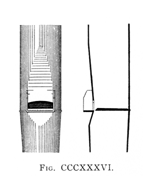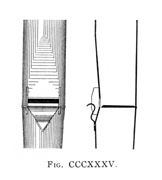
|
Salicional English? Salizional German? | |
|
Salicionale Italian Salicinal (unknown) Salcional (unknown) Solacinal (unknown) Solcional (unknown) Solicional (unknown) |
Fistula Salicis Latin Salicis Fistula Latin Salicet (unknown) Salycional Latin Weidenflöte German Weidenpfeife German |

These names, of which Salicional is by far the most common, derive from the Latin salix, meaning “willow”. Salicis Fistula means “willow pipe”, a rustic flute made from a branch of a willow tree. Dating from the late 15th century, it was originally, according to Williams, rather flute-like in tone, but later evolved into a string stop whose tone varied considerably across centuries and continents. In the 17th century the Salicional was a specialty of Habsburg Europe, from which Snetzler brought it to England where it became very popular in the 19th century. Wedgwood tells us that the German Salicional was a “horny” string, the French variety a quiet Diapason, and the English variety a slightly stringy Dulciana. Bonavia-Hunt and Maclean describe its ideal tone as an echo Geigen. Skinner claimed the Salicional as a stop native to America, and voiced it more keenly than his Gambas. Now one of the most common string stops, it is most often found at 8' pitch, but can also be found at 16', 4', and rarely 2'. At 8' pitch it is often accompanied by the Voix Celeste.
While some sources consider it to be a synonym for Salicional, most sources define Salicet as a Salicional of 4' pitch. Weidenflöte may or may not be a synonym.
Compare with Sollicinal.

The Salicional is almost invariably made of open cylindrical metal pipes, though examples have been made of wood, of conical construction, and even inverted conical. The mouths tend to be small, typically 1/6 to 1/5 the circumference, making ears common to stabilize the speech. Mouth heights vary; Bonavia hunt specifies 1/5 to 2/9, Audsley claims they rarely exceed 1/3, while Skinner advocated a high cut-up. A common feature is a roller beard or harmonic bridge, particularly in the low and middle ranges, such as that shown in Audsley's drawing reproduced here. The pipes are sometimes slotted, sometimes not. Audsley provides the following scales, and advocates a maximum of 3 3/8" at 8' C:
| Source | Ratio | 8' C | 4' C | 2' C |
|---|---|---|---|---|
| Audsley / F. Hass | 1:2.66 | 3.21" | 1.97" | 1.20" |
| Audsley / T. C. Lewis | 1:2.66 | 3.34 | 2.05 | 1.25 |
| Audsley | 1:2.66 | 3.08 | 1.89 |
Skinner's Salicionals ranged from 2 17/32" to 3 1/4" at 8' C.
|
Salamine Contra Salicional - a 16' Salicional Double Salicional - a 16' Salicional Echo Salicional Salicet - a 4' Salicional |
Salicetina - a 2' Salicional Salicetbass - a 16' Salicional Salicional Celeste Salicional Diapason Voix Celeste |
Osiris contains over 600 examples of Salicional, of which about 5% are at 16' pitch, about 3.5% are at 4' pitch, and about 1% at 2' pitch, the rest being at 8' pitch. Osiris contains 34 examples of Salizional at 8' pitch, and two examples each at 16' and 4' pitch. Osiris contains ten examples of Salicionale, all at 8' pitch. No examples are known of Salicis Fistula, Solcional, Salicinal, or Solacinal. Contributions welcome. All known examples of Salcional, Solicional and Fistula Salicis are listed below.
Salizional 8', Hauptwerk; Church of the Virgin Mary Before the Týn, Prague, Czechoslovakia; Mundt 1673. May have been added in 1823.
Salizional 8', Manual I; Baden-Württemburg, Ochsenhausen, Germany; Gabler 1755.
Salcional 8', Choir; Town Hall, Leeds, England; Gray & Davison 1859.
Salcional 8', Swell; United Methodist Church, Bemidji, Minnesota, USA; Wicks 1939.
Solicional 8', Hauptwerk; Käppele, Würzburg, Germany; Vleugels 1991.
Fistula Salicis 8', Organo Grosso; Chiesa di San Tommaso Apostolo, Castelfranco di Sopra, Italy; unknown 1824.
Salicionale 8', Recitativo; Chiesa di S. Ignazio, Rome, Italy; Tamburini 1933.
See the Sound Files appendix for general information.
| Salicional 8', Swell | Kellogg Auditorium, Battle Creek, Michigan, USA | Aeolian-Skinner, 1933 | St. Anne | |
| Salicional 8', Swell | Culver Academies, Indiana, USA | Burger & Shafer 1972; Möller pipes | arpeggio | St. Anne |
|
Copyright © 1999 Edward L. Stauff, all rights reserved. Salicional.html - Last updated 13 February 2009. |
Home Full Index |